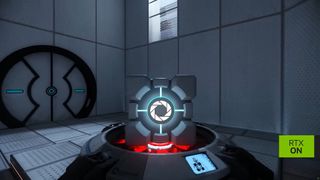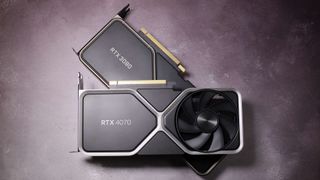Portal with RTX has been updated to include Nvidia's latest load time accelerating GPU tech
Portal RTX has always been fairly system demanding, but these new additions may lessen some of the strain for RTX GPU users.

Recent updates
Our pre-release information didn't reference the inclusion of Ray Reconstruction with the new Portal with RTX release, but we can confirm that the improved ray tracing feature has now been added to the classic game. We've been seriously impressed with Ray Reconstruction in its Cyberpunk 2077 guise, so it's great to see it added to another path-traced title.
Portal with RTX has developed a bit of a reputation as a good stress test for even the most powerful of systems since the DLC was released back in 2022, thanks to its use of some heavy-duty path-traced illumination. However, the most recent update introduces some new Nvidia tech for those running an RTX GPU, with some faster asset loading and the latest version of DLSS.
The new update adds support for Nvidia RTX IO, a technology that first made its debut alongside the free Portal: Prelude RTX Remix mod last year. RTX IO makes use of GPU-level decompression to enable faster texture load times by allowing compressed data to be delivered to the GPU and decompressed via GDeflate, freeing up the CPU for other tasks.
This new addition is said to reduce texture load timeshare by up to five times, and also reduce the disk drive footprint of Portal with RTX by 37%.
Another addition in the new update is the introduction of DLSS 3.5, although with no mention thus far as to whether ray reconstruction might be part of the feature set. Ray reconstruction is a separate API for DLSS 3.5, like Super Resolution or Frame Generation, so it won't necessarily be making an appearance unless the devs choose to include it.
Given the demanding nature of the path-traced illumination involved, it strikes that this would be a good opportunity to implement the tech, particularly as the game seems to be pushing the boundaries of cutting edge lighting implementation as things stand. We'll have to have a play around with the update ourselves to find out, but even without ray reconstruction, DLSS 3.5 is a welcome addition.

Best CPU for gaming: The top chips from Intel and AMD.
Best gaming motherboard: The right boards.
Best graphics card: Your perfect pixel-pusher awaits.
Best SSD for gaming: Get into the game ahead of the rest.
Unlike the previously implemented DLSS 3, DLSS 3.5 supports all RTX-series GPUs going back to the 20-series, so if you struggled to maintain a good frame rate on an older RTX card this might be your opportunity to jump back in and check it out for yourself.
Even without the help of these new features, surprising things have been achieved with the game before despite its heavy system demands, like getting it to run at a playable 30 fps on the Steam Deck thanks to some tweaking of the RTX Remix developer menu. Quite an achievement in a game so demanding.
The biggest gaming news, reviews and hardware deals
Keep up to date with the most important stories and the best deals, as picked by the PC Gamer team.
Still, it seems like with the most recent update, Portal with RTX remains on the leading edge of graphics technology and the tools developed to run it well, and these new additions should hopefully deliver a better experience for RTX users that struggled before.

Andy built his first gaming PC at the tender age of 12, when IDE cables were a thing and high resolution wasn't. After spending over 15 years in the production industry overseeing a variety of live and recorded projects, he started writing his own PC hardware blog in the hope that people might send him things. And they did! Now working as a hardware writer for PC Gamer, Andy's been jumping around the world attending product launches and trade shows, all the while reviewing every bit of PC hardware he can get his hands on. You name it, if it's interesting hardware he'll write words about it, with opinions and everything.
Most Popular






